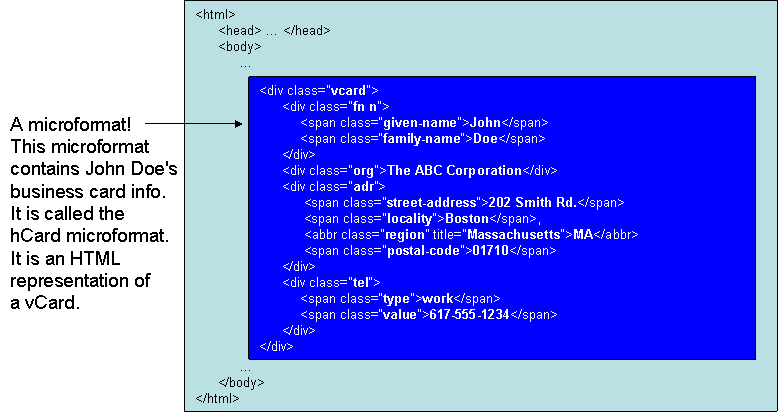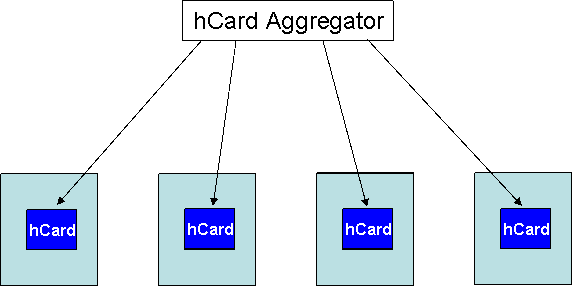Purpose of Microformats
- The purpose of Microformats is to make Web documents smarter.
- HTML, XHTML, BLOGS, RSS, ATOM, XML
- In these tutorials I will primarily demonstrate Microformats with HTML and XHTML documents; but remember that Microformats also apply to other Web documents.
- Let's spend a few minutes reviewing HTML. Then we will examine how Microformats can be used to make HTML documents smarter.
HTML
- HTML is a general-purpose markup language for describing document (i.e., structural) properties of information.
- Below is an example of information that has been marked up using HTML tags. It is an HTML representation of John Doe's business card.

Browser Rendering

HTML Semantics
- The
divandspantags are particularly devoid of helpful semantics. - However, HTML does have more semantic-rich tags. The tags in the example below indicate an "unordered list" of "items". These tags are more semantic-rich.
- But even these tags are lacking: they don't tell you that the list is comprised of information about a book.

Purpose of Microformats
- The purpose of Microformats is to enrich the semantics of Web documents.
- However, there is more to the story than just enriching the semantics of Web documents. Read on ...
No New Markup
- When the Microformat's initiative began in 2005, they decided that they wanted to create something that Web developers could use immediately. They wanted a Semantic Web now!
- This meant no changes to the existing set of HTML tags.
Semantic Labels
- The Microformat community hunted through the HTML specification looking for ways
to enhance the semantics, and they found it: the class attribute.
- Actually, the class attribute is one of three attributes that the Microformat's community identified for enhancing the semantics of HTML pages: class, rel, rev.
- Nearly every HTML tag has an optional class attribute. That attribute can be used to add a "semantic label" to data.

- The class value "street-address" has added semantics to the data!
Many Ways to Mark Up Data
- Consider a Web developer providing street address data in his Web document.
- Depending on how the data is being used, the street address data may be marked up
using a
spantag, or it may be needed in a list and thus embedded within alitag, or it may be marked up in countless other ways.

No Impact to Presentation

- Microformats don't care what HTML tag you use.
- Microformats only cares that you attach a class attribute onto the tag and then use the appropriate value for the class attribute.
Standardized Class Values
- Imagine if every Web developer (or every organization) created his own semantic labels (i.e., class values). Web pages would have enriched semantics only within the Web developer's circle of users.
- But outside that circle of users the semantic labels would have no meaning. Rather than enriching the whole Web,
user-defined semantic labels would fracture the Web into many non-interoperable pieces.
- This is known as The Tower of Babel.
- A key insight by the Microformat's community is that semantic labels must be created in a controlled, standardized process.
Example Microformat

Aggregating Microformats

- An hCard aggregator searches the Web looking for Web pages that contain hCard Microformats. The result is a service capable of providing business card info to the Web community!
Purpose of Microformats (Revised)
- The purpose of Microformats is to:
- Enrich the semantics of Web documents.
- Enrich the semantics of the whole Web.
- In a bottom-up, grassroots fashion, one Web document at a time.
- Create standard semantic labels.
- Via a clearly defined community process.
- Leverage existing standards (don't reinvent).
Brilliance of Microformats
- Web developers mark up their Web documents as they ordinarily would.
- They are then invited to make their documents more semantically rich by adding class attributes with standardized semantic labels (i.e., class values).
- There is no impact to the document's presentation.
- There is a big (positive) impact on how effectively the document's information can be processed by Web applications.
- Tiny changes to Web documents facilitate huge, immediate changes to the overall semantic richness of the Web.
Wisdom of Microformats
- In his book, The Wisdom of Crowds, James Suroweicki says that to effectively harness the
collective intelligence of a crowd - such as the Web - there needs to be the right balance between:
- making individual knowledge globally and collectively useful
- allowing individual knowledge to remain resolutely specific and local
- The Microformats approach has found the right balance:
- Microformats provide the semantic labels that enable individual knowledge to be collected, aggregated, and processed
- Simultaneously, at the local level Web page developers are empowered to express their individual knowledge in a fashion that is best suited to their specific problem
- See the Making Local Knowledge Globally Useful
Unanticipated Mashups
- Hyperlinks are considered fundamental to the Web. And deservedly so. They enable a Web document to connect to other documents. Stated differently, they enable information to connect to other information.
- In today's world the emphasis is on being able to "combine information". That is, we want to do mashups.
- Consider a Web document that links to another document. One can envision an application which combines the two documents. Thus, an application can mashup the Web document with the documents it is linked to.
Unanticipated Mashups (cont.)
- But what about mashups with other documents, for which it does not link to? That is, what about unanticipated mashups?
- Continued ... Microformats Enable Unanticipated Mashups
Reference
- For an explanation of why enriching the semantics of the Web involves more than just creating good
semantic labels, see this slide show by Tantek Celic:
- More Than Just "Good Class Names" (Note: use your arrow keys to navigate through his slide show)
- Homepage
 ) to navigate to next page
) to navigate to next page